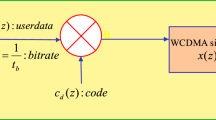Abstract
Orthogonal frequency division multiple access (OFDMA) is a promising technique, which can provide high downlink capacity for the emerging wireless systems. The total capacity of OFDMA can be maximized by adaptively assigning subcarriers to the users with the best gains for those subcarriers, with power subsequently distributed by water-filling. In this paper, we propose the use of artificial bee colony (ABC) algorithm combined with Deb’s selection mechanism to handle the constraints. In this scheme, a probabilistic selection scheme assigns probability values to feasible solutions based on their fitness values and to infeasible individuals based on their violations, to allocate the resources to the users in downlink OFDMA system. Specifically we propose two approaches for resource allocation in downlink OFDMA systems using ABC algorithm. In the first approach, ABC algorithm is used for subcarrier allocation only, while in second approach the ABC algorithm is used for joint subcarrier and power allocation. It is shown that both these approaches obtain higher sum capacities as compared to that obtained by previous works, with comparable computational complexity. It is also shown that the joint subcarrier and power allocation approach provides near optimal results at the cost of slightly higher computational cost.











Similar content being viewed by others
References
Lawrey, E. (1999). Multiuser OFDM. In Proceedings of international symposium on signal processing and its applications, pp. 761–764.
Tse, D., & Viswanath, P. (2005). Fundamentals of wireless communication. Cambridge: Cambridge University Press.
Gheitanchi, S., Ali, F. H., & Stipidis, E. (2007). Particle swarm optimization for resource allocation in OFDMA. In Proceedings of IEEE DSP07 conference, pp. 383–386.
Jang, J., & Lee, K. B. (2003). Transmit power adaptation for multiuser OFDM system. IEEE Journal on Selected Areas Communications, 21, 171–178.
Kim, I., Park, I. S., & Lee, Y. H. (2006). Use of linear programming for dynamic subchannel and bit allocation in multiuser OFDM. IEEE Transactions on Vehicular Technology, 55, 1195–1207.
Reddy, Y. B. (2007). Genetic Algorithm approach for adaptive subchannel, bit, and power allocation. In Proceedings of the 2007 IEEE international conference in networking, sensing and control, pp. 15–17.
Sharma, N., Rao, A., Dewan, A., & Safdari, M. (2008). Rate adaptive resource allocation for multiuser OFDM using NSGA II. In Proceedings of IEEE conference on wireless communication and sensor networks, pp. 161–166.
Shen, Z., Andrews, J. G., & Evans, B. L. (2003). Optimal power allocation in multiuser OFDM systems. In Proceedings of IEEE global communications conference, pp. 337–341.
Shen, Z., Andrews, J. G., & Evan, B. L. (2005). Adaptive resource allocation in multiuser OFDM systems with proportional rate constraints. IEEE Transactions on Wireless Communications, 46, 2726–2737.
Tang, Z., Zhu, Y., Wei, G., & Zhu, J. (2007). Cross-layer resource allocation for multiuser OFDM systems based on ESGA. In Proceedings of the 66th IEEE vehicular technology conference, pp. 1573–1577.
Wong, C. Y., Cheng, R. S., Lataief, K. B., & Murch, R. D. (1999). Multiuser OFDM system with adaptive subchannel, bit and power allocation. IEEE Journal on Selected Areas Communications, 17, 1747–1758.
Wong, I. C., Shen, Z., Evans, B. L., & Andrews, J. G. (2004). A low complexity algorithm for proportional resource allocation in OFDMA systems. In Proceedings of IEEE international workshop on signal processing systems, pp. 1–6.
Ashourian, A., Homayoun, R. S., & Nasab, M. (2013). A low complexity resource allocation method for OFDMA system based on channel gain. Wireless Personal Communications, 71(1), 519–529.
Karaboga, D., & Basturk, B. (2007). A powerful and efficient algorithm for numerical function optimization: artificial bee colony (ABC) algorithm. Journal of Global Optimization, 39, 459–471.
Karaboga, D., & Akay, B. (2011). A modified artificial bee colony (ABC) algorithm for constrained optimization problems. Applied Soft Computing, 11, 3021–3031.
Deb, K. (2000). An efficient constraint handling method for genetic algorithms. Computer Methods in Applied Mechanics and Engineering, 186(2–4), 311–338.
Ahmad, I., & Majumder, S. P. (2008). Adaptive resource allocation based on modified genetic algorithm and particle swarm optimization for multiuser OFDM systems. In Proceedings of IEEE international conference on electronics and communication engineering, pp. 211–216.
Ahmadi, H., & Chew, Y. H. (2010). Subcarrier-and-bit allocation in multiclass multiuser single-cell OFDMA systems using an ant colony optimization based evolutionary algorithm. In Proceedings of IEEE wireless communications and networking conference, pp. 1–5.
Ahmadi, H., Chew, Y. H., & Chai, C. C. (2011). Multicell multiuser OFDMA dynamic resource allocation using ant colony optimization. In IEEE 73rd vehicular technology conference: VTC2011-Spring, pp. 1–5.
Malla, S., Ghimire, B., Reed, M. C., & Haas, H. (2012). Energy efficient resource allocation in OFDMA networks using ant-colony optimization. In International symposium on communications and information technologies (ISCIT), Vol. 1, pp. 889–894.
Ahmadi, H., & Chew, Y. H. (2012). Evolutionary algorithms for orthogonal frequency division muntiplexing-based dynamic spectrum access systems. Computer Networks, 56(14), 3206–3218.
Mezura-Montes, E., & Coello, C. A. C. (2005). A simple multimembered evolution strategy to solve constrained optimization problems. IEEE Transactions on Evolutionary Computations, 9(1), 1–17.
Venkatraman, S., & Yen, G. G. (2005). A generic framework for constrained optimization using genetic algorithms. IEEE Transactions on Evolutionary Computations, 9(4), 424–435.
Chai, Z., Liu, F., Qi, Y., & Zhu, S. (2012). On the use of immune clonal optimization for joint subcarrier and power allocation in OFDMA with proportional fairness rate. International Journal of Communication Systems. doi:10.1002/dac.1395.
Karaboga, D., & Akay, B. (2009). A comparative study of Artificial Bee Colony algorithm. Applied Mathematics and Computation, 214, 108–132.
Storn, R., & Price, K. (1997). Differential evolution A simple and efficient heuristic for global optimization over continuous spaces. Journal of Global Optimization, 11(4), pp. 341-359.
Rechenberg, I. (1965). Cybernetic solution path of an experimental problem, library translation. In Royal aircraft establishment, Farnborough, Hants, p. 1122.
Akay, B., & Karaboga, D. (2012). A modified Artificial Bee Colony algorithm for real-parameter optimization. Information Sciences, 192, 120–142.
Author information
Authors and Affiliations
Corresponding author
Rights and permissions
About this article
Cite this article
Sharma, N., Anpalagan, A. Bee colony optimization aided adaptive resource allocation in OFDMA systems with proportional rate constraints. Wireless Netw 20, 1699–1713 (2014). https://doi.org/10.1007/s11276-014-0697-y
Published:
Issue Date:
DOI: https://doi.org/10.1007/s11276-014-0697-y




